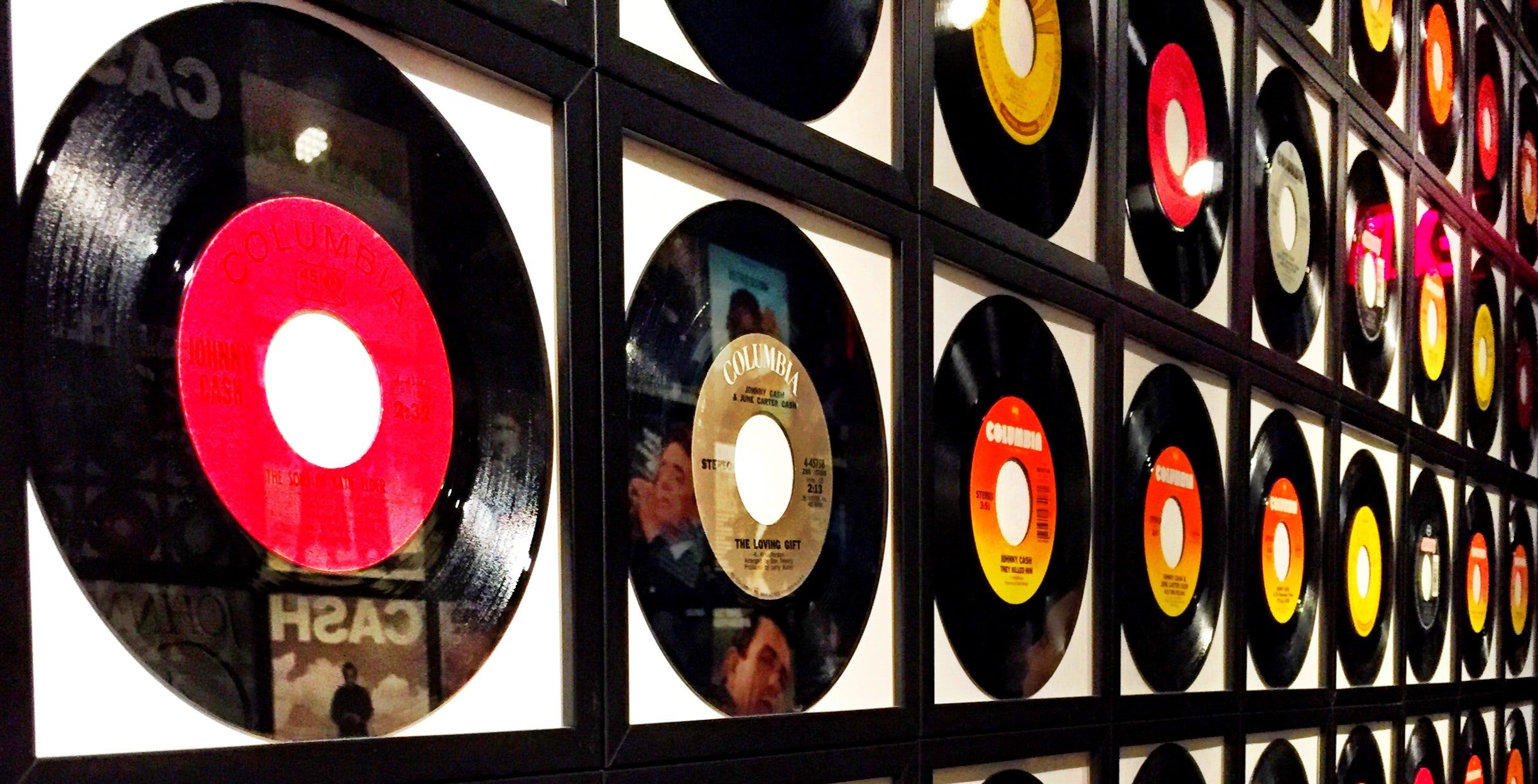
Collecting seven-inch singles played a great part of my teenage years. But what of the 45 rpm record? How did it come about?
Well, in the late 1940s, two innovations would change the way music was listened to in the home. They were, to pardon the pun, revolutionary.
From beetles to Beatles
Since 1910 and up to the end of WWII, records had been made of shellac, a material made from the excretions of the lac beetle. They had been 10 or 12 inches in diameter and spun at 78 rpm (revolutions per minute).
They were the best solution at the time, but they had a great drawback in that they would shatter if dropped. Another drawback was the amount of music that could be fitted onto them. Coming in at around 5 minutes, people wanted more.
As far back as 1931, RCA thought they had found a solution. Their “program transcription” discs spun at 33⅓ rpm and were made of shellac or a new material, an early plastic known as Victrolac. There were several drawbacks:
- The Depression meant that people could not afford the hardware to play the new-fangled discs.
- Poor fidelity – they sounded rubbish, and
- The heavy tonearms meant that the discs, especially the Victrolac ones wore out very quickly.
By 1933, the format was made redundant. Edward Wallerstein, RCA Victor’s new General Manager, decided to remove the format from the market due to these issues.
Format war
Roll forward to 1948 and Wallerstein, now General Manager at Columbia, RCA Victor’s main commercial rival oversaw the launch of another new format. Again, played at 33⅓ rpm, these discs were 12 inches in diameter but made from a new material called Vinylite.
Perhaps the most technical innovation was the grooves. Called micro-grooves, they were only 0.003 inches wide and enabled 22 minutes of music to be played on each side. Columbia copyrighted their name for these new, long-playing records. The LP™ was born.
And, unlike shellac, these discs would not shatter if dropped. New lighter tone arms also meant that records would not be destroyed in normal use either.
RCA Victor had not been idle during these years either. Just a year after the release of Columbia’s new system, their own technological masterpiece was released to the market.
Also made from the new Vinylite, but with a diameter of just 7 inches, RCA Victor’s new 45 rpm record held, like the original shellac 78s, just 5 minutes of music per side. In contrast to Columbia’s LP system, with an entire album on just one disc, the 45 rpm record harked back to the idea of albums as a collection of media items, as the existing 78 rpm technology did.
RCA’s ‘head in the sand’ period
So whilst Columbia’s offering would have an entire piece of classical music on one disc, RCA’s version of the same would still be a collection of discs, sold in boxes. RCA’s selling point was that these would take up less space than the same album on 78. They paid no heed to the Columbia system.
Taking this pig-headedness to the nth degree, unlike Columbia who almost straightaway produced their records and albums in all formats (78 rpm, 33⅓ rpm and 45 rpm), it took RCA Victor another twelve months to cotton on that it was a good idea to follow suit.
Turntable manufacturers, such as Philco, were very quick out of the blocks with machines which could play all three formats. This necessitated the manufacture of inserts for the middle of 45 rpm records, which because of RCA’s system of record changers, had a 1.5-inch diameter spindle hole, rather than the 0.283-inch diameter hole of standard 78s and Columbia’s LP discs.
Record rapprochement
The 78 slipped quietly away by the end of the fifties whilst both the LP on 33⅓ rpm and the 45 rpm record went from strength to strength. That they managed to co-exist during the fifties and sixties, each meeting different needs is a testament to the market, allowing people to choose what they wanted. In those early days, between the late forties and 1954 when one Elvis Aaron Presley burst onto the scene, music was aimed primarily at the older generation.
Then, during the fifties, RCA produced their 45 rpm record players at a much more affordable price and teenagers soon began to buy single, stand-alone records whilst their parents continued with long players.
So, what started as a format war morphed into beneficial coexistence. By the time the sixties had arrived the UK singles chart had been published in the New Musical Express (NME) for eight years. In the US, Billboard magazine had published lists of record sales for a good deal longer and indeed had gone for categorisation in a big way. In the UK, a top seller was a top seller whatever its genre.
What were the first 45 rpm records?
As mentioned, these tough little things have been about since March 1949 when RCA Victor first released them. The first releases were quite the eclectic mix.
They ranged from classical through kids’ music to country. Perhaps the most famous song was That’s All Right, a track written and performed by Delta Bluesman, Arthur William Crudup, known as Big Boy.
That’s All Right, of course, became Elvis Presley’s debut on Sun Records in 1954. Also in the original RCA list, is a Yiddish song, A Klein Melamedl (The Little Teacher), sung by cantor Saul Meisels.
However, the first 45 rpm record pressed was Pee Wee the Piccolo by Paul Wing, with Russ Case and his Orchestra. It was released as a double pack, with sides 1 and 4 on the first disc and 2 and 3 on the second. As befitting the original intentions of RCA Victor, it was issued on yellow vinyl. Because it was classed as Blues and Rhythm (sic) by RCA, That’s All Right was released on orange vinyl.
Popularity increases
Going forward, 45 rpm single records became more popular. It’s a moot point whether this was because of RCA or despite RCA. Their marketing of record players at much more affordable prices certainly did not harm, but their attitude towards records themselves did require adjustment.
No matter, once the likes of Elvis and Bill Haley had made their breakthroughs, the trend for teenagers buying music began to accelerate and the charts began to reflect this. For example, in the earliest days of the UK singles chart (i.e., before Elvis), artists such as forces sweetheart Vera Lynn and all-American girl Doris Day rubbed shoulders with crooners (and staples of the US chart) such as Al Martino, Frankie Laine, Bing Crosby and Nat King Cole. By the middle of the fifties in the US and the late fifties in the UK, more often than not, the likes of Elvis, Bill Haley, Jerry Lee Lewis, and Buddy Holly were number one in the charts.
Peaceful coexistence
By the time the sixties rolled around, the 45 rpm record and the 33⅓ rpm LP were complimenting each other. Singles would be released ahead of the release of an LP to publicise it. Singles that did not feature on an LP release would be issued as promotional material in their own right.
Take the Beatles, for example. In the UK, many Beatles 45 rpm records were released as stand-alone work that did not feature on any original LPs in the UK. This policy was not followed in the US, where almost a completely different catalogue of singles and LPs was released.
Also, in the 60s we saw albums with tracks beyond the capacity of a single 45 rpm record. Clearly here, RCA’s 45 rpm system would have had to break them up into chunks – something that the LP did not need to do. Imagine Pink Floyd’s Dark Side of The Moon, with three tracks coming in at six minutes and more being split up to enable it to be listened to on the 45 rpm format. It, and other such tracks by other artists, more than likely would not have been recorded.
And finally…
So, although borne out of a late 40s format war, the 45 rpm record and the LP did end up complimenting each other and indeed their technology is so robust that despite a blip in the late 80s, continuing into the 90s, both are still used as vehicles for the release and promotion of new music.


hey simon 🙂
thx for the article, it was very interesting to learn about the history of 45 rpm records. i’ve always been curious about how they came about. it’s crazy to think how different materials and innovations shaped the way we enjoy music.
i can’t imagine dealing with those old shellac records that would shatter if dropped. vinylite and micro-grooves sound like game-changers.
my grandpa actually had some old 45 rpm records, and I remember playing them as a kid. It’s nostalgic to think about how music formats have evolved.
it’s cool how the 45 rpm records and LPs coexisted and served different needs. the evolution of the music industry is fascinating, and it’s interesting to see how technology and formats have shaped the way we consume music.
thanks for sharing htis piece of music history with us!
Thanks, Matias, though you have made me feel old as I have a stack of ‘old’ 45s and I’m not a grandfather yet 😉
Usually, in a format war, one format wins and the other is consigned to history. It’s great that they were both able to find their niche and provide solutions to different problems. I wonder if 78s hadn’t existed first (with their small capacity) that the 45 would have managed to survive? Hmm…
Simon 😉